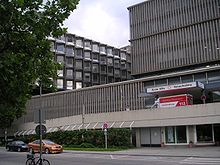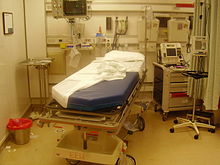Emergency department
![]()
This article explains the emergency admission in the medical sense. For the former emergency admission procedure for GDR refugees in the FRG, see Emergency admission procedure.
The emergency room (also rescue center, emergency room, emergency outpatient clinic, emergency ward, emergency assistance, emergency center or first aid station) is a point of contact in the hospital for acute care and is part of emergency medicine. Every hospital (exception: private clinics, rehabilitation hospitals) has an emergency room, which is usually open around the clock and where medical assistance is provided.
In the eastern states of Germany, the term "rescue centre" is more widely used instead of "emergency room". Here, the abbreviation RTS is also commonly used. In the old federal states as well as in Austria, the term "emergency room" (also "emergency ambulance", "emergency assistance" or "emergency admission") is more commonly used. In Switzerland, the emergency room is called "emergency ward". Sometimes, out-of-hours polyclinics of hospitals also function as emergency rooms.
Only emergencies are treated in an emergency room. As a rule, ordinary outpatient care is not provided there. Certificates of incapacity for work are not issued. In hospitals with an accident surgery department, the treatment of occupational accidents (D-doctor procedure) is often spatially affiliated to the emergency department, whereby certificates of incapacity for work can also be issued by them following occupational accidents.
Patients are not necessarily treated in the order of their arrival, but according to urgency. The correct assessment of patients (triage) is therefore a very important measure in the emergency department. For this purpose, the vital signs (blood pressure, pulse, respiratory rate) and often also additional values such as oxygen saturation or heart rate are measured for each patient, or existing measurement data and information provided by the rescue service personnel are taken into account. The urgency of the treatment can then already be assessed by the nursing staff on the basis of flow charts and checklists (e.g. Manchester triage system).
Some emergency departments also have a separate ward (called an "admission ward" in many hospitals) where longer-term treatments are carried out and patients for whom admission to hospital is medically necessary wait for a free bed.
In any case, once a patient has stabilized, the emergency room physicians must decide whether it is necessary to keep a patient in the hospital as an inpatient or to discharge him or her from the emergency room. If necessary, there is also still the possibility of temporarily placing the patient in a day hospital for further observation (for example, in some cases of hypoglycaemia). Until a few years ago, when a patient was discharged, hospital staff would often request an ambulance to take them home safely. Now, trips home are only paid for if there is a medical indication for it. This must be stated by the attending physician on the transport certificate ("TN").
In emergency departments, doctors from different specialties (e.g. anaesthetists, surgeons, internists) usually work on patients alone or together in collegial consultation (interdisciplinary emergency department, also called central emergency department or ZNA). The advantage of a ZNA is that patients only need to know one point of contact and doctors from all disciplines can be called in quickly for consultations. In Anglo-American countries, medical work in emergency rooms is an independent specialty ("emergency medicine").
In addition to interdisciplinary emergency rooms, in which illnesses from all medical disciplines are treated, there are also specialist emergency rooms, which only accept accident surgery (e.g. broken bones) or internal medicine (e.g. blood poisoning) emergencies. A possible advantage of specialist emergency rooms is the distribution of the patient volume over different rooms and thus a better overview, a lower noise level, as well as a lower risk of mutual infection.
Nowadays, special emergency rooms also include trauma centres. They are staffed and equipped (shock room) for the most seriously injured. The chances of survival and the success of treatment in a specialised trauma centre are significantly higher than in ordinary surgical emergency departments.
With the so-called stroke units, there is another relevant facility in many emergency rooms that is oriented towards the treatment of stroke patients. More and more emergency rooms also have chest pain units where patients with acute coronary syndrome are diagnosed and treated by cardiologists.

Emergency ward of the University Hospital Zurich

Emergency Department of the Benjamin Franklin University Hospital, Berlin

Emergency room after the treatment of a patient

Shock room in the emergency room of the University Hospital Mannheim
See also
- Emergency practice for cases that are not immediately life-threatening
- Medical emergency service, also called on-call service
Search within the encyclopedia